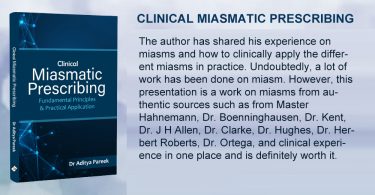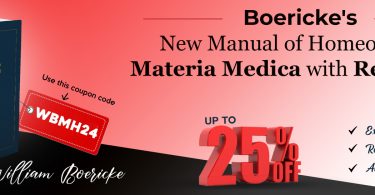Advanced Learner’s Guide to Practice: How to work out cases with the combined use of various repertories?—A dissertation on Mechanical versus Artistic Way of prescribing.
Theory is good so far as it goes, but who can infuse theory into practice, lives in, with and for the student!—Dr. R. Del Mas
A teacher is he who makes difficult things easy— Ralph Waldo Emerson
Mrs. X, 61 years
PATIENT: Back pain. When I get gastric complaints (which I get only when taking food in hotel or wedding parties) I get back pain. [It is not in one place; sometimes it is in the neck, sometimes— lower back and sometimes in the left shoulder.]
Whenever I get gastric problems, along with it, I also get mental depression. One strange thing I noticed; once the gastric symptoms disappear, both backache and mental depression vanish almost instantaneously.
My question: How long have you had this?
Patient’s answer: For about fifteen years. Qn.: When was your menopause?
Ans.: At my 45th year.
DR KRISH/MRS. X, 61 YEARS 09-05-2019 1
Qn.: Did this gastric complaint start a few months after menopause or was it there even before complete stoppage of menses?
Ans.: Gastric and back pain started six months after menopause.
Symptoms (for repertorisation) in this case are:
Congestion. When a distant part is affected with a complaint in a part, we must take the rubric Congestion in Kent’s Repertory under the last chapter GENERALITIES. E.g., headache while coughing; mind symptoms during dyspepsia; complaints immediately before, during or after menses; also when more than one complaint is found in a part; e.g., a patient complains of headache and dandruff. The neophyte types these two words in the computer; it is not correct. ‘Congestion’ is the term to be pressed into service when a patient is having two or more symptoms in one part. So also, two or more complaints in any part above neck; here too we have to take the rubric ‘congestion.’ Similarly, a patient complains of pain in knee, swelling and varicose veins in legs; in this case, three complaints are in the lower limb. If you take these three symptoms separately for repertorisation, you would miserably fail. Two or more affections in the lower limb, we must consider the remedies given under the rubric ‘Congestion’ in the last chapter GENERALITIES in Kent’s Repertory.
DR KRISH/MRS. X, 61 YEARS 09-05-2019 2
Merely telling that homoeopathy is based on symptoms is vague and misleading; by this, a student does not learn anything. Let us now go to the next symptom to be considered in the above case.
Readers to note: What the patient brings is cotton; we have to make thread out of it, then weave cloth and then stitch a shirt or pant; put buttons, pocket etc. and now it is ready for wearing. A patient will not say that six months after menopause he got gastric pain. The above patient is sixty-one years old;
She told gastric complaints; then I asked, ‘How long?’ and her answer was “fifteen years.” By deducting 15 from her age 61, I deduce it is from her 45th year of age; (this is the menopause period). To know whether I
should take menopause for repertorisation, I ask her whether the gastric complaint started while she was still menstruating or it started a few months after complete cessation of menses. She replies that it was six months after that. For this, the rubric is ‘checked discharges.’ Kent’s Repertory has no such rubric and here comes our great Samuel Lilienthal’s most valuable reference work HOMOEOPATHIC THERAPEUTICS (hereinafter called Lilienthal’s.) (on page 1005-1006) under the chapter “Suppression of Secretions”, we find the following:
Suppression of haemorrhage or abandoning habitual depletions: 1. Acon., Bell., China, Ferr., Nux v., Puls., Sulph.; 2. Arn., Aur., Bry., Calc., Carbo-v.,
DR KRISH/MRS. X, 61 YEARS 09-05-2019 3
Graph., Hyos., Lyc., Nat-m., Nit-ac., Phos., Ran., Rhus., Seneg., Sep., Sil., Spong., Stram. [Let us call this as List ‘A’]
Kent’s Repertory—Generalities—Congestion: Several remedies. In Kent’s Repertory when a rubric contains more than 7-10 remedies in top-grade, it is sufficient if you take top-grade remedies only. [Let us call this as List ‘B’]
Remedies common to List A and B above are: Acon., Bell., Chin., Ferr., Nux-v., Phos., Puls, Sulph. (Let us call this as List ‘C’]
The patient said that the pain in back is shifting: For this, we go to page 958 in Boericke’s Repertory and under the chapter GENERALITIES we find the following:
Complaints wander, or shift about, erratic, changeable: Apis., Bell., Benz-ac., Berb. vul., Dios., Ign., Kali-bich., Lac-c., Lil-t., Mag-p., Magnolia, Mang ac., Phyt., Puls., Sanic., Syph., Tub. (Let us call this as List ‘D’]
Remedies common to List ‘C’ and ‘D’ above are: Belladonna and Pulsatilla.
To confirm one of the two remedies for the patient, let us study them in Lilienthal’s (in the Chapter RHEUMATISM):
DR KRISH/MRS. X, 61 YEARS 09-05-2019 4
Page 919: Belladonna.—Red, shining swelling of joints of erysipelatous appearance; stitching . . .
Page 927.—Pulsatilla.—Gastric symptoms prominent; rheumatism, . . . often shifting from one part to another. .
We are quoting only those lines relevant for the case. Pulsatilla-10M, one single dose, gave total relief to the patient. Note: Many practitioners raise the objection that Lilienthal’s contains only a few symptoms but we have to prescribe on ‘totality-of-symptoms.’ These practitioners terribly lose sight of Section 153 of the Organon, which says that we have to prescribe on ‘uncommon-rare-strange-peculiar’ symptoms. Such uncommon symptoms in any given case are only one or two. Lilienthal’s contains only uncommon symptoms! Section 153 is not in the terminology of 99% homoeopaths. Again, 99% of homoeo college lecturers/ professors are still ignorant of Lilienthal’s. Our medical system would soon be lost for humanity without Lilienthal and Dr. W. A. Yingling’s Accoucheur’s Emergency Manual.



